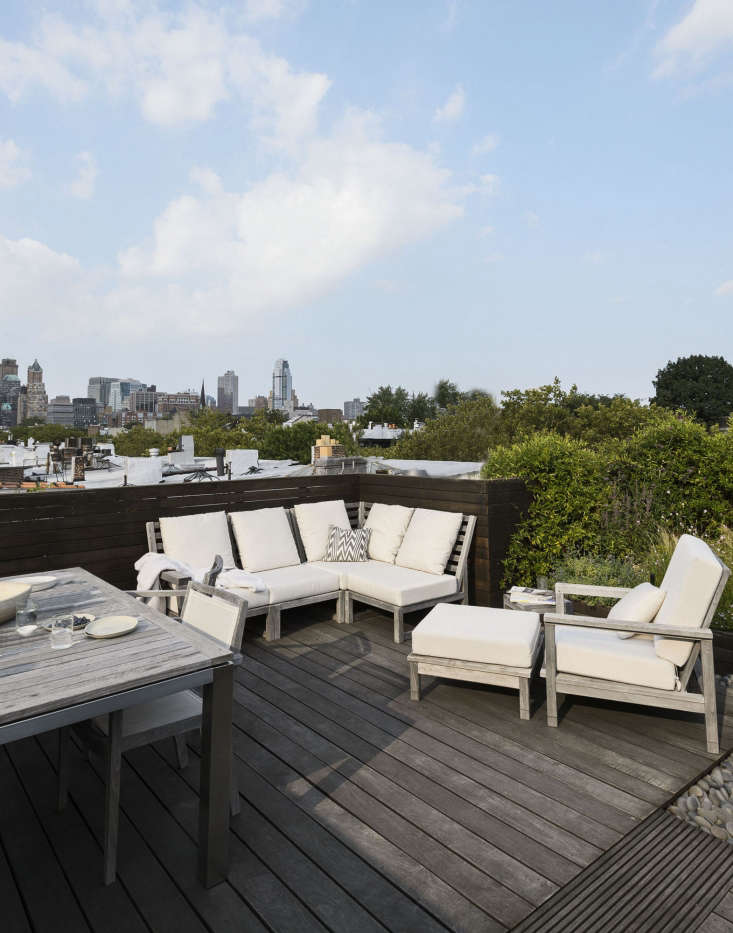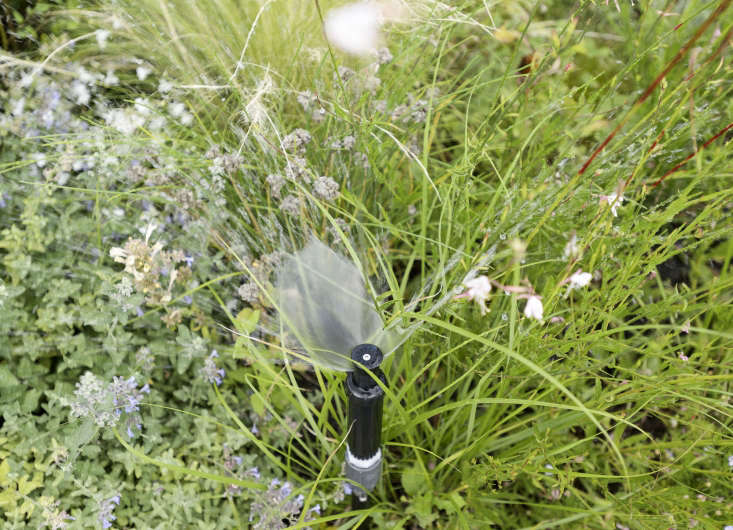“A roof garden is the ultimate optimization of space in an urban area,” says Julie Farris, a landscape designer and founder of XS Space. “You can have a garden on top of your house without buying more land. If it’s done right, you’ll completely forget you’re in a city—and you don’t need to work that hard to maintain it.”
Julie created a magical roof garden for her family at their home in Cobble Hill, Brooklyn (you can read about it in our book, Gardenista: The Definitive Handbook to Stylish Outdoor Spaces, and see additional photos below).
Here are Julie’s 10 top tips for building a roof garden using beds or planters set on a roof. (N.B.: One of Julie’s projects that we featured was a finalist in Architizer’s A+ Awards contest. Here’s the link to vote: Greenwich Village Townhouse.)
Photography by Matthew Williams for Gardenista.

1. Make sure your roof can support the weight.
Gardens can weigh quite a lot—soil is heavy and wet soil is even heavier. So when you’re doing any kind of significant roof design, you must bring in a structural engineer, says Julie. Period. The potential risks to your home from roof damage far outweigh the cost of an evaluation.
An engineer will run calculations for various types of loads, including the weight of snow (depending on your location). If you’re planning to do significant planting, you’ll probably need steel reinforcement—and the cost can vary widely, depending on the condition of the roof and the size and scope of the garden. The only way to know is with a stamped engineer’s report.
Tip: Know the difference between a green roof and a roof garden. A green roof is partially or completely covered with vegetation, such as sedum, planted in a growing medium over a waterproof membrane. (For more, go to Hardscaping 101: Green Roofs. Green roofs are ideal for larger areas, and can help insulate your house, reduce water runoff, filter pollutants, and cool the air. “They also look quite beautiful. But the typical green roof covers the roof and isn’t meant to be walked on,” says Julie. “A roof garden, whether or not it has flowerbeds, is meant to be visited and enjoyed.”

2. Design with your climate in mind.
In terms of design layout, if there are no taller buildings around yours, the garden will be exposed to 360 degrees of weather 365 days a year. You’ll need a hardscape and plants that can deal with a lot of sun, wind, and freeze/thaw conditions. That means materials that wear well, and plants that are drought-tolerant and sun-loving.
“Few people feel like hauling to the nursery every weekend to buy replacement planting, so make sure the plants you select can survive tough conditions,” Julie says. For any extensive project, you’ll need to enlist a professional to design the project, get local approvals, and perform the work.

3. Design for the way you want to use the space.
How will your family use your garden? The context (that is, your specific site conditions) combined with your preferences will dictate the core of your design. If you love gardening, you’ll want more planted beds. If you don’t have the time or inclination, go for more hardscape with select planted areas.
Does your family include kids or a dog? If so, you’ll definitely want to make it safe for them—and provide a play area (if you have the space). If you plan daytime use, you’ll probably need to arrange for shade cover. Very few umbrellas can handle the wind conditions on a roof, so a more permanent element, like a trellis, is recommended.
The more logistical details you work out up front, the better. Do you entertain often? How many people do you generally have at a dinner? How will you get plates and glasses up and down? Do you want a bin for storing chair cushions and other essentials?
“Since we have kids, we set back our garden 12 feet from the roof edge for safety—even though it made our garden smaller,” says Julie. “We enclosed the space with an iron railing and put large planters in front of the railing. Your local building codes will specify the height requirement for roof railings; note that there shouldn’t be any horizontal structural members that kids could climb on.”

4. Get the right hardscape materials and a soil mix.
First, start with a high-quality waterproof membrane that’s well sealed. Never place anything sharp on the membrane—if it’s punctured and starts to leak, your entire roof can be damaged. A root barrier is another must whenever you’re planting directly on the roof surface, as are J-Drain drainage mats and a constructed edge to retain the soil. If the soil doesn’t drain properly, plants will not survive.
To lighten the load and help with drainage, add a two-inch layer of Styrofoam peanuts on top of the J-Drain mat. For planters, thin sheets of insulation on the sides and bottom will help with freeze-thaw conditions.
If you’re using pavers, they should be lightweight and elevated from the roof surface so water can drain underneath. (These are called Pedestal Pavers; you can find them specifically for rooftop projects.)
And yes, you need to buy a soil mix that’s specifically designed for a roof garden. These are generally made of shale, compost, light gravel, and sand; it’s difficult (and costly) to try to create your own.

5. Make it easy to get onto the roof.
“Spiral staircases are often used to save space, but I’m not a fan,” says Julie. “I find them dizzying, inconvenient if you’re carrying things, and troublesome for little kids. Besides, I don’t think they look good. I prefer a conventional staircase, even if it takes up more room.”

6. Choose the right irrigation system.
Most roof gardens should be watered twice a day, every day during the growing season. If you can’t do that, you need to install an automatic irrigation system. Drip-line irrigation (and drip heads for planters) is best, but to get it right, hire a company that specializes in roof gardens.

7. Don’t skimp on lighting.
You want lighting if you plan to use your garden at night. If you’re starting from scratch, you can make your lighting system a significant (and functional) design element. You might install recessed lights in a wall, or recessed pin lights along a walkway, or a wall-mounted fixture outside the door or over a grill.
If you’re retrofitting and don’t want to bring in an electrician, consider solar lighting. Be warned that you have to spend a bit more to get solar lights that are both stylish and functional, such as the Luceplan Solar Bud.
The easiest approach: lanterns with candles. “These can provide just the right light for entertaining, and they’re a great accent,” says Julie. “I really like the Ventana Teak Lantern from Restoration Hardware.”

8. Choose plants with care.
“My favorites tend to be the plants I see coming back season after season, despite the stress of city living and my daily neglect,” says Julie. Tried-and-true perennials in Brooklyn are grasses such as Miscanthus and Nasella, Monarda, Achillea, Calamagrostis, Clematis, Gaura, Dianthus, Phlox, Agastache, Nepeta, thyme, Molinia, lavender, tea roses, St. John’s wort, and Amsonia.
“To find out what will work best in your area, ask your neighbors and the experts at the closest nursery,” says Julie. “I’m lucky to have Four Gardens just down the street from me in Brooklyn; I never do anything plant-related on any project without the input of Four Gardens plant expert Julia Miller.”
For plants to attract pollinators or create habitats for birds, consult with your local nursery to find out what works best in your area. “I’ve sighted many hummingbirds on my roof, and I think they come for the Monarda (bee balm),” says Julie. “Asclepius (butterfly weed) is obviously a major butterfly attracter that’s lovely too.”
Bees are drawn to many native perennials that provide pollen and nectar, such as purple coneflowers, lavender, Nepeta (catmint), Coreopsis, salvia, and roses. Some other good additions are Calamintha, autumn-flowering clematis, and honeysuckle. Our Carolina Jessamine (a Jasmine climber) is home to a nest of sparrows.
Tip: Avoid plants that prefer moist acidic soil; they won’t thrive on a roof. “I also avoid plants that require shade (assuming the roof gets full sun) and that bear fruit—they can make a mess,” says Julie. “Basically, most annuals require too much effort; I prefer a low-maintenance garden.”

9. Make a roof garden feel intimate instead of exposed.
Plants with some transparency are ideal for a roof garden—they give a sense of privacy without blocking the view. Tall grasses such as Calamagrostis and Miscanthus, which move gracefully in the wind, are perfectly suited to roof climates. Shrub roses are also a good choice—my English roses bloom twice a season.

10. Consider maintenance and upkeep.
Julie deliberately designed a low-maintenance roof garden for her family: “Someone from Four Gardens comes over for cleanups and replanting two or three times a year. The spring replant depends on whatever didn’t make it over the winter—usually about 10 percent of the plants. They also clean the mesh chairs, pick leaves and other debris out of the stones, and oil the Ipe wood decks. We power-wash and sand the wood every three years before oiling.”
Any last thoughts, Julie? “I should have installed a dumbwaiter! They’ve gone out of style, but we should bring them back for roof gardens. Getting things up and down would be so much easier.”
If you’re designing a new garden (big or small), get started with our curated guides to Garden Design 101, for tips on Decks & Patios 101, Gravel Gardens, and Privacy Fences. For more design ideas for roof gardens, see:
- A Manhattan Roof Garden with a Panoramic View
- Roof Garden: Cottages in the Mill Valley Forest
- Hardscaping 101: Green Roofs
- A Secret Roof Garden in Spitalfields










Have a Question or Comment About This Post?
Join the conversation